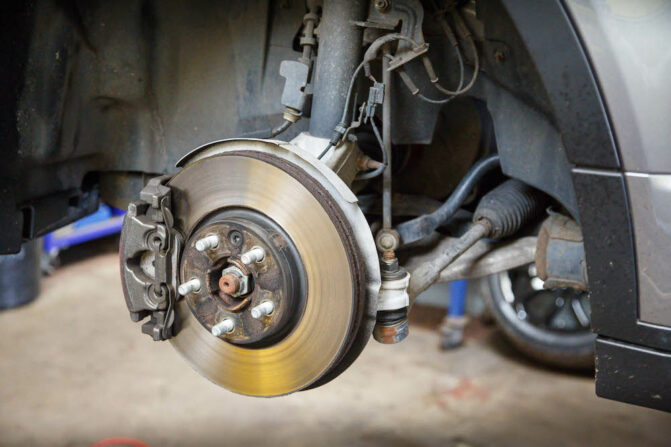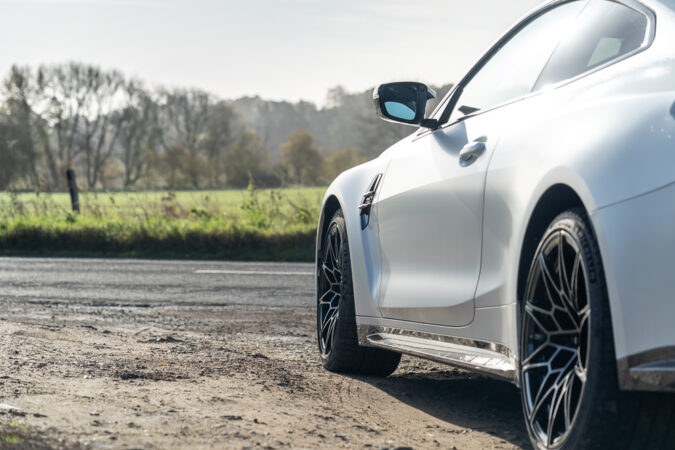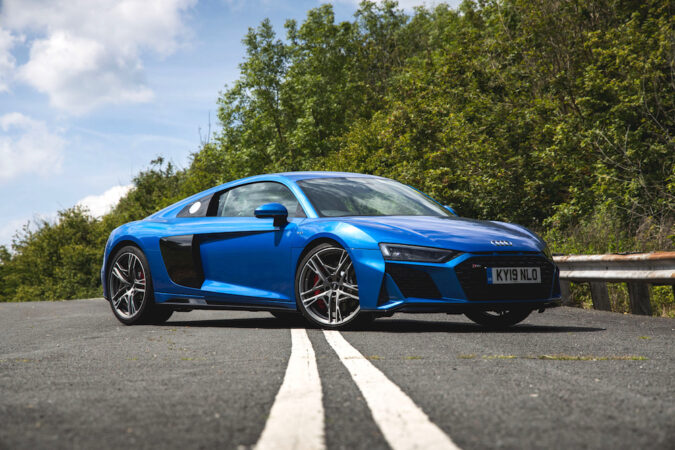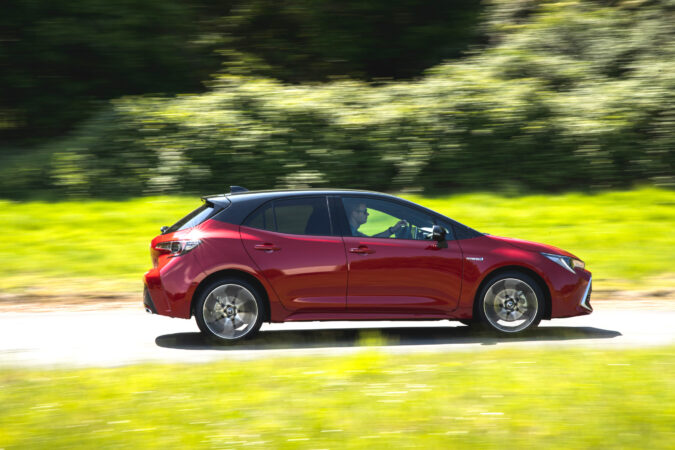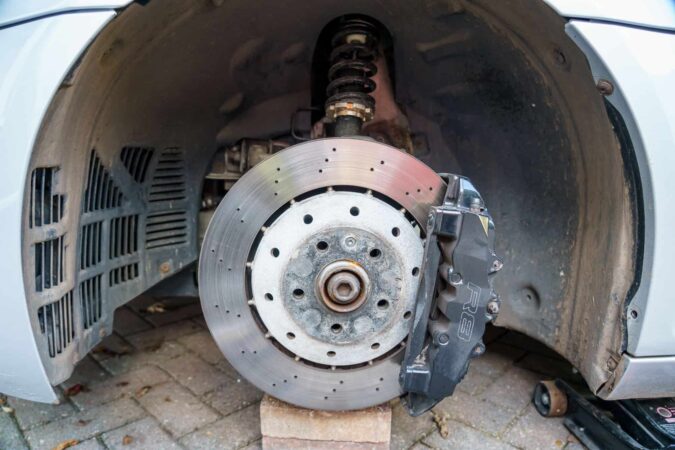When you’re going through a car brochure, you might notice the suspension spec is usually either a MacPherson strut or a double wishbone suspension, sometimes both. But what are they exactly? And when it comes to MacPherson strut vs double wishbone, which one is better?
Both are types of car suspension assemblies. They serve the same purpose but are two different engineering solutions. And they both come with their own set of advantages and drawbacks. This post is going to take a look at both of them. Here’s the table of contents to help you navigate:
- What’s A Car Suspension?
- MacPherson Strut
- Double Wishbone
- Which One’s Better?
- Other Suspension Types
- FAQ
- Conclusion
What’s A Car Suspension?
Before we get into it, a brief introduction to the car suspension system: the car suspension is a system that consists of several components where its primary job is to ensure optimum handling performance and ride comfort in the car.
In a nutshell, the car suspension’s job is to absorb the motions the car experiences as it travels to make it as comfortable as it possibly can for the occupants. And to ensure the car handles well in almost any condition.
As you’ll learn in this post, there are several different types of suspension systems. But every system will have these components:
- Some sort of damper, usually a shock absorber or a strut, along with a coil to absorb and control the motion of the car.
- One or more linkages that connect the suspension to the chassis and the wheels to the steering system (for the front suspension).
That’s the basics of a car’s suspension system. As mentioned, there are several types of suspension systems. We’ll focus on MacPherson strut vs double wishbone in this post, but we’ll briefly touch on other suspension systems as well.
MacPherson Strut VS Double Wishbone: A Look At MacPherson Strut
So, let’s take a look at the MacPherson strut first. The MacPherson strut is named after the inventor, Earle S. MacPherson who was an American automotive engineer.
The MacPherson strut is a type of independent suspension. This means that the suspension in each corner of the car can move independently which allows for an overall better ride in the car. The MacPherson strut suspension assembly is commonly used for the front suspension. And you’ll find this suspension in almost every front-wheel-drive car.
The assembly consists of a lower control arm, the wheel hub, a steering link (if used on the front wheels), and a strut damper with a coil spring to absorb bumps and potholes on the road. Additionally, it’s usually connected to the suspension on the other side of the car via an anti-roll bar.
You might notice that even though it’s an independent suspension, it still connects to the opposite side via an anti-roll bar. However, they won’t affect the movement and operation of the other too much. The anti-roll bar needs to be there to ensure the suspension doesn’t lean too much during fast cornering. And this ultimately helps to minimize body roll.
One last thing to note is that the control arm can either be in a wishbone shape or an L-shape. It all depends on the manufacturer, but all MacPherson struts only have one control arm. Unlike the double wishbone suspension, which we’ll get into later on.
That’s essentially how the system works and what the assembly looks like. Now, let’s take a look at its advantages and drawbacks:
MacPherson Strut: Pros & Cons
The MacPherson strut has three main advantages:
- It allows for more independent movement between the suspension units. This makes the car more comfortable on the road.
- The design takes less horizontal space, allowing more space for the engine and drivetrain components. This also allows for the wheels to be easily connected to a drive shaft, which is why it’s great for front-wheel-drive cars.
- It has fewer components, making them cheaper to produce than most other suspension types. Moreover, this also makes them lighter and it’s good to reduce weight in a car.
So, the MacPherson strut is relatively simple, cheap to produce, and it makes for a smoother ride. But it does come with some drawbacks:
- It takes a lot of vertical space. This means the car will have to sit quite high off the ground and limits how much you can lower the car. It also means it’s not ideal for performance cars, as they typically need to sit lower to the ground to improve handling.
- The vertical nature of the assembly may also hinder handling because it can cause the tires to lose contact with the road more easily.
- The design inherently allows for slight camber changes over time due to body roll. At a certain point, this can affect the handling, and you may need to do a wheel alignment more often.
Overall, the MacPherson strut is a good suspension that combines comfort, practicality, and low manufacturing cost. While the drawbacks limit its application, it’s still the ideal suspension system for many cars.
MacPherson Strut VS Double Wishbone: A Look At Double Wishbone Suspension
The double wishbone is also an independent suspension system just like the MacPherson strut. The name comes from the wishbone-shaped arms that connect the wheels to the chassis. Unlike the MacPherson strut, it has two arms; an upper and lower one – hence the name double wishbone.
The double wishbone typically uses a shock absorber rather than a strut for damping, but it often still has a coil spring as well. Another thing you should know about the assembly is that it usually connects via the chassis, rather than an anti-roll bar. Take a look:
As the video above demonstrates, the damper and spring can be mounted in two ways. It can mount on the upper control arm, but a more common setup is to mount it on the lower control arm. This allows for a more compact design and allows the car to sit lower to the ground.
Now, let’s take a look at the pros and cons of the system:
Double Wishbone: Pros & Cons
Here are the main advantages of using a double wishbone suspension setup:
- It can take less vertical space, meaning that it can allow for more passenger space. This is why you’ll mostly see a double wishbone setup at the rear of the car, as this allows for more room for the cabin.
- The design allows for more camber adjustments, especially negative camber. This can be beneficial for handling, depending on how the manufacturer sets the car.
- It prevents camber changes over time. You will still need to do a wheel alignment, but the job will likely be less complicated.
Of course, the double wishbone setup also has its drawbacks:
- The system takes a lot of room and will require some clever engineering to allow a driveshaft to connect to the wheels. This is why it’s more often used for non-driven wheels.
- It has more parts, making it more expensive to manufacture, costly to repair, and heavier.
- The system has more interdependence between suspension the units. This means the movement of the suspension on one side can affect the opposing side. This can result in a less comfortable ride.
The double wishbone suspension is also very popular even to this day. While more expensive than the MacPherson strut, it’s still cheaper and simpler to produce than many other suspension systems, making them a popular option.
You’ll see this suspension in many cars, such as the Toyota Tundra, many Mercedes-Benz vehicles, and even the current Audi R8.
MacPherson Strut VS Double Wishbone: Which One’s Better?
So, MacPherson strut vs double wishbone, which one’s better? Well, they both come with their own set of advantages and drawbacks. And when deciding which one is better, it depends on the car itself and what it needs to do.
A MacPherson strut is cheaper to produce and lighter, but it won’t be ideal for performance cars due to the ride height issue. This is why you’ll commonly find them in “regular” cars such as hatchbacks, sedans, and crossover SUVs.
Meanwhile, the double wishbone is generally more well-rounded. This is why you’ll see them in anything from the rear-end of a hatchback, to trucks and body-on-frame SUVs, and even in current supercars such as the Audi R8. However, the packaging constraints may pose an issue and can add up to the cost.
There’s no one-size-fits-all solution when it comes to car suspension systems. It all depends on the type of car, what it needs to do, and of course, the production cost concerns as well.
Keep in mind that some cars employ both suspension types. It all depends on the car’s needs. For example, the Toyota Corolla uses MacPherson struts for the front suspension since it’s front-wheel drive and it needs the space to connect the driveshaft to the front wheels.
However, you’ll find the rear of the Corolla (in certain markets) uses the double wishbone setup. This is because the double wishbone takes less vertical space, and this allows the engineers to give the car more cabin or luggage space.
Note that in the US, the Corolla uses a multi-link rear suspension setup. The double wishbone is used in certain markets, mostly in Asia. This brings us to other suspension types:
MacPherson Strut VS Double Wishbone: Other Suspension Types
As mentioned, this article is meant to focus on MacPherson strut vs double wishbone setups. But we can’t help mentioning these other suspension setups, we just love sharing our car knowledge. On top of the MacPherson strut and double wishbone, here are some other suspension designs that might interest you:
Independent Suspension Types
Most cars today will have some sort of independent suspension since they allow for better ride quality and handling. Here are the types of independent suspension you should know about:
- Multi-link Suspension. As the name suggests, it has several links that connect the wheel to the car’s frame. The main benefit is that it can flex more, allowing the car to conform to varying angles while driving.
- Trailing Arm Suspension. This refers to a system where the suspension link is connected to the frame perpendicularly to the axle. This suspension allows for more flex without the complexity of a multi-link suspension, making it ideal for offroad cars.
- Air Suspension. An air suspension system is not the type of assembly itself, but rather the type of damper. Instead of shocks/struts and coil springs, it uses pressurized rubber bellows otherwise known as air springs. They can almost infinitely adjust the air spring, which allows for greater comfort.
- Hydropneumatic Suspension. This suspension uses compressed gas to control the car’s ride. When one wheel goes over a bump, it will send pressurized air into the other suspension units to ensure the body remains level, making the ride more comfortable. A similar system is a Hydrolastic system which uses hydraulic fluid rather than air.
The multi-link suspension is probably the most popular type of suspension after the MacPherson strut and double wishbone, especially for mid-range and higher-end performance cars. Most cars usually use between 3 to 5-link suspension.
Solid Axle Or Rigid Suspension
A solid axle or rigid suspension means that the suspension units on an axle cannot move independently. This means whatever movement one suspension is experiencing, the suspension on the other side will experience it as well. Here are some common types of solid axle suspension:
- Leaf Springs. This suspension uses multiple layers of steel springs that have two connections to the chassis. It’s not comfortable, but it’s cheap to produce, hence why you’ll mostly see it in commercial vehicles, entry-level trucks, and body-on-frame SUVs, especially in the Asian market.
- Solid Axle Coil Spring. This is also a type of rigid suspension. However, it uses coil springs and dampers to absorb bumps and control the ride, making it more comfortable than leaf springs. It’s still isn’t very comfortable, as every movement will affect the suspension on the other side of the axle.
A solid axle suspension is inherently less comfortable than independent suspensions. However, they’re simple and cheap to produce, making them the ideal option for commercial and offroad vehicles where comfort isn’t the main concern.
MacPherson Strut VS Double Wishbone FAQs
Got any more questions about car suspension systems? The answer you’re looking for might be below:
How Much To Repair A MacPherson Strut?
This depends entirely on what parts in the suspension you need to repair or replace. Many parts will wear down over time, this includes the control arm itself and bushings, and the struts.
The bushings are usually anywhere between $250 – $300 for each axle, including labor. While the control arm itself is usually between $100 – $500 each for most cars but luxury cars may cost more than that.
Meanwhile, the struts are usually around $150 – $300 each, but labor will add at least another $200 to the bill. Additionally, most of the time you need to replace both struts on an axle. This means the parts alone will be around $300 – $600.
How Much To Repair A Double Wishbone Suspension?
Costs for replacing parts in a double wishbone system are largely the same, it depends on what components you need to change. The only difference is that the double wishbone has more control arms and bushings.
This means there are more potential failure points. So, while the cost for an individual part is not far off, you may need to replace more parts leading to a more expensive repair cost. You can also expect the labor cost to be higher, as the system is more complex and will likely need more labor hours to finish the job.
Can I Change The Suspension System In My Car?
You can change the damper and springs in your car, there are plenty of aftermarket parts that you can choose from. However, if you’re thinking of replacing the entire system, such as from a MacPherson strut to a double wishbone system, realistically you wouldn’t be able to do that.
It’s technically possible, but this will require a lot of engineering and customization work. It’s realistically not possible, and not something you’d want to do to your road car anyway.
If you’re looking to improve the ride in your car, consider swapping your strut or shock absorbers with an air suspension system. There are plenty of aftermarket air suspensions that you can choose from.
Meanwhile, if you’re looking to improve performance, a popular option is getting a coilover. A coilover refers to an aftermarket damper system where you can adjust the height and stiffness. This allows you to adjust them as you see fit, and with the right setup, you can improve the handling of your car.
An air suspension system typically costs between $500 – $1,500 including labor, but some systems can cost up to $3,000 to install. Meanwhile, coilovers can start as low as $350, and installing them is typically easier. However, most coilovers will set you back between $600 – $1,000.
What Are The Signs Of A Bad Suspension System?
The signs of a bad suspension system depend on what components have gone bad. For example, bad bushings can cause the steering wheel to vibrate. It can also make the car feel less stable to handle.
Meanwhile, a bad control arm will exhibit similar symptoms. However, it can also make clunking noises as you drive along, and cause the steering to become crooked when driving in a straight line.
Meanwhile, if your shock absorbers or struts have gone bad, you will typically notice more body roll when cornering. The car will also bounce more when you go over a bump or a pothole. And if the front dampers have gone bad, the front of your car will dive when braking.
Regardless of what problems you have, it will be a good idea to fix them as soon as possible. Neglecting them can cause further damage to other suspension parts, and can even cause excess wear in the transmission.
How Can I Maintain My Car’s Suspension?
If your car has shock absorbers or struts for the dampers, here are the things you can do to maintain the system:
- Check your wheel alignment, misaligned wheels can cause suspension components to wear out more quickly.
- Maintain proper tire pressure (you can learn more in our explainer on the tire pressure for Honda CRV). You can find the recommended pressure on a sticker on the driver’s door, it’s usually between 32 – 36 PSI for most cars unless you’re carrying heavy loads.
- Make sure your power steering is working properly.
- Don’t drive on a spare tire (if it’s a space saver – make sure you’re wary of how far can you drive on a spare tire) for too long. This can also induce excess wear on the car’s transmission and differential.
If you have an air suspension, doing the things above will also help to maintain it and extend the system’s lifespan. However, you should do a regular check of the system and make sure the air line connections and the air springs have no leaks.
How Long Does A Suspension Last?
This depends on the car, the suspension type, and how you drive the car. If you tend to abuse it, or if you’re not careful over a bumpy road, it can shorten the suspension’s lifespan.
On average, you can expect the entire system to last about five years or 50,000 miles before you need to do repairs. However, the suspension system in some cars may last up to 10 years or 100,000 before any repairs are necessary.
Vehicle Suspension: Basics, Designs, and Maintenance
- The suspension system of a vehicle works with the steering system to give the driver control, absorb bumps in the road, and prevent excess body lean.
- The two most common suspension designs are double wishbone and MacPherson struts, which differ in their construction, weight, and performance characteristics.
- Double wishbone suspension is commonly found in body/frame construction vehicles, while MacPherson struts are typically used in unibody designs.
- Double wishbone suspension is more complex in design, making it more delicate and with more parts that can fail.
- MacPherson struts are simpler in design, providing a smoother ride at highway speeds, but they can raise the profile of the vehicle and transmit more noise through the body.
- Double wishbone suspension allows for a lower center of gravity, better contact with the ground during cornering, and less torque steer, making it ideal for smaller-body performance cars.
- Maintaining the suspension system requires checking the components regularly, with MacPherson struts recommended to be checked every 50,000 miles, and replacing worn parts promptly to avoid collateral damage to other components.
- Double wishbone suspension designs can have problems holding alignment when parts wear significantly, requiring regular inspection and replacement of worn parts.
- To find the right replacement parts, it’s recommended to use the VIN lookup on an auto parts website to ensure compatibility with the make and model of the vehicle.
- There are newer MacPherson-style designs that improve efficiency by separating the strut from the steering geometry, which helps to lower torque steer and improve performance.
MacPherson Strut VS Double Wishbone: Wrap Up
So, to summarize, the MacPherson strut and double wishbone are both a type of a car’s suspension system. The two systems are similar, with the main difference being in the placement of the damper and the number of control arms that it uses.
A MacPherson strut is simpler and cheaper to produce. Its simple design allows for a driveshaft to be easily connected to the wheels, hence why a lot of front-wheel-drive cars use this system for the front suspension.
Meanwhile, the double wishbone system has more parts, making it more expensive to produce and heavier as well. However, it can resist camber angle changes due to body roll. And since it takes less vertical space, the car can sit lower to the ground and the car can have more cabin space.
Now you know the main differences, benefits, and drawbacks of each system. This should help you make sense of that spec sheet the next time you’re planning to buy a car. If not, at least now you have some new knowledge to share with your friends the next time you go out!

